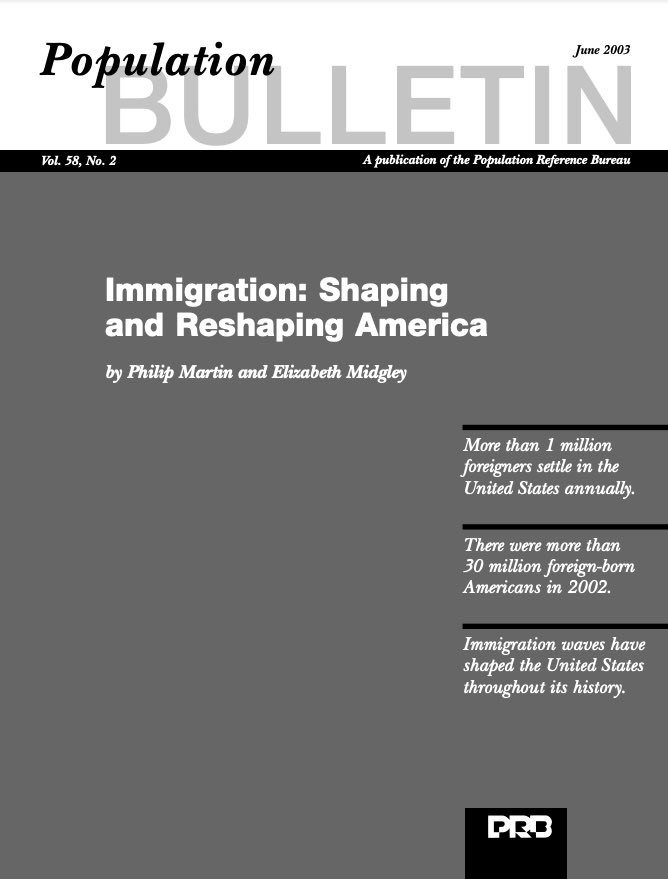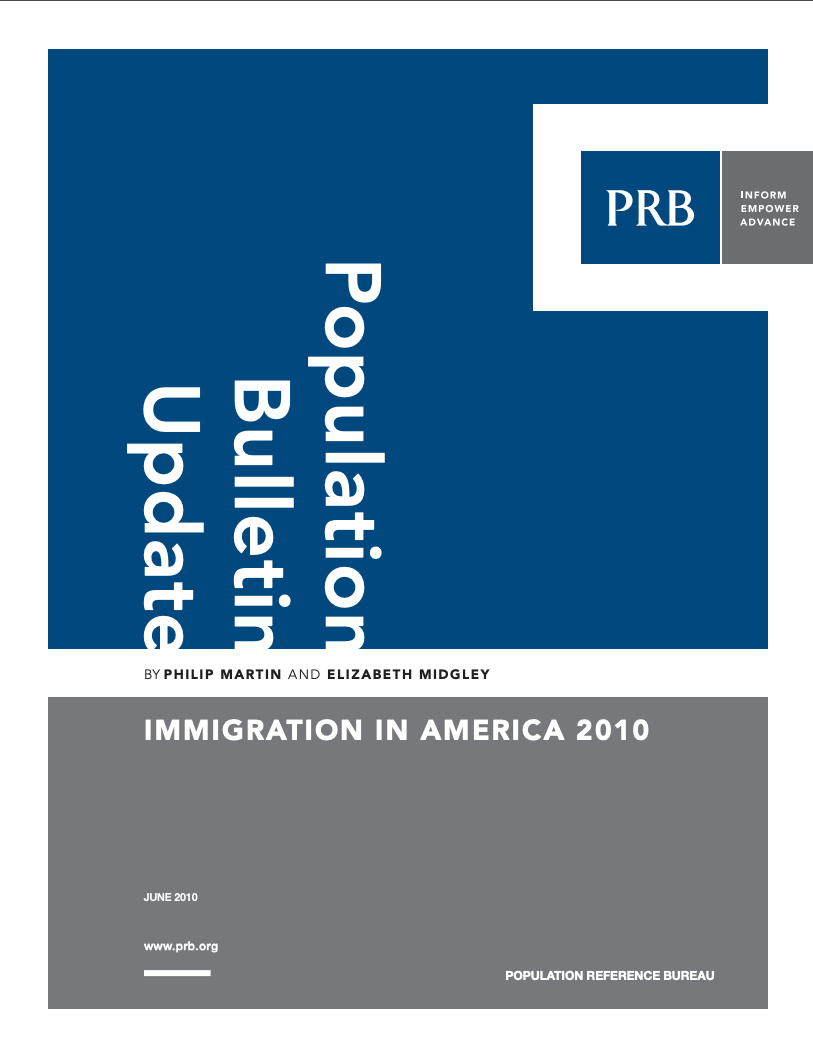
Number of Foreign-Born Reaches All-Time High in U.S.
(June 2003) The United States has always had a significant foreign-born population, but the number of foreign born reached an all-time high of 32.5 million in 2002 — equal to 11.5 percent of the U.S. population — according to the Current Population Survey (CPS).1 During the peak years of immigration early in the 20th century, the number of foreign-born residents was lower, but they made up a larger share of U.S. residents. In 1910, for example, there were only 13.5 million foreign-born residents, but they represented 15 percent of all U.S. residents.
Most foreign-born residents are fairly recent arrivals: About one-half of the 2002 foreign-born residents arrived in 1990 or later. They are highly concentrated in a few states. Nearly 60 percent lived in one of four states in 2002: California (with 28 percent of the total), New York, Florida, or Texas. But the sharpest increases in foreign-born residents since 1990 were in other states, such as Nevada, where the foreign-born population rose from 105,000 to 386,000 between 1990 and 2002, and North Carolina, where it rose from 115,000 to 381,000.
Not all foreign-born residents are immigrants. Demographer Jeff Passel estimates that at least 3 percent are nonimmigrants, including foreign students, diplomats, and temporary workers, and some will return to their countries of origin. Between 7 million and 9 million are unauthorized foreigners, which means that only about 75 percent of all foreign-born residents are legal immigrants. One reason for the range in the estimate of unauthorized foreigners is that some demographers count foreigners with a quasi-legal status as unauthorized, and others treat them as authorized.
More than one-half of the 2002 foreign-born residents were born in Latin America — with 30 percent from Mexico alone. Twenty-six percent were born in Asia, 14 percent in Europe, and 8 percent from Africa and other regions.
Foreign-born residents age 18 or older are more likely than the U.S.-born to be in the U.S. work force, but they are younger, less educated, and have lower annual earnings. A recent analysis of the 2002 CPS showed that the average age of a U.S.-born worker who worked full-time at least part of 2001 was 41 years, and median earnings were $31,200.2 For foreign-born residents, the average age was 39 years, and median earnings were $24,000. Foreign-born residents who arrived in 1990 or later — half of the total — were much younger and had much lower incomes: Their average age was 32 and median earnings $20,000. These low earnings reflect the fact that 34 percent of these recent arrivals were not high school graduates. By contrast, 16 percent of U.S.-born residents had not finished high school.
U.S.-Born and Foreign-Born Population, 1980 to 2000
| U.S.-born | Foreign-born | |
|---|---|---|
| Number in millions | ||
| 1980 | 226.5 | 14.1 |
| 1990 | 248.7 | 19.8 |
| 2000 | 281.4 | 31.1 |
| Percent change | ||
| 1980–1990 | 9.8 | 40.4 |
| 1990–2000 | 13.1 | 57.1 |
Source: U.S. Census Bureau, Statistical Abstract of the United States: 2000 (2002): 45.
Foreign-born residents were 14.5 percent of the 121 million U.S. workers employed full-time for at least part of 2001. Immigrants were 44 percent of private household workers, 42 percent of those with nonmanagerial farming occupations, and 20 percent of operators, fabricators, and laborers.
About 16 percent of foreign-born residents, and 11 percent of U.S.-born residents, had incomes below the poverty line in 2002. By country of origin, about 26 percent of those born in the Dominican Republic were poor, as were 20 percent of those born in Mexico and Pakistan, and 20 percent of those born in Cuba and Honduras. About 24 percent of households headed by foreign-born residents obtained a means-tested federal benefit in 2001, versus 16 percent of households headed by a U.S.-born resident: The most common benefit used by both groups was Medicaid. Country of origin data for welfare use track poverty data — 59 percent of households headed by a person born in the Dominican Republic obtained a means-tested federal benefit in 2001, as did 36 percent of those headed by a person born in Mexico, 35 percent of those headed by a person born in Cuba, and 33 percent of those headed by a person born in Haiti.
Many foreign-born residents are in their prime childbearing years, so the percentage of births to foreign-born women is higher than their share of U.S. residents. In 2001, 22.5 percent of the 4 million births in the United States were to foreign-born women; 63 percent of births to Hispanics were to mothers born outside the United States.3
Philip Martin is professor of agricultural economics at the University of California–Davis, chair of the University of California’s Comparative Immigration and Integration Program, and editor of Migration News. Elizabeth Midgley is president of Working English, a foundation that helps newcomers learn English.
References
- Dianne Schmidley, “The Foreign-Born Population in the United States: March 2002,” Current Population Reports P20-539 (2003).
- Steven A. Camarota, “Immigrants in the United States-2002,” Backgrounder (Washington, DC: Center for Immigration Studies, November 2002).
- Joyce A. Martin et al., “Births: Final Data for 2001,” National Vital Statistics Report 51, no. 2 (2002): 45.
- This article is excerpted from PRB’s upcoming Population Bulletin, “Immigration: Shaping and Reshaping America.”

 ">
">
 ">
">